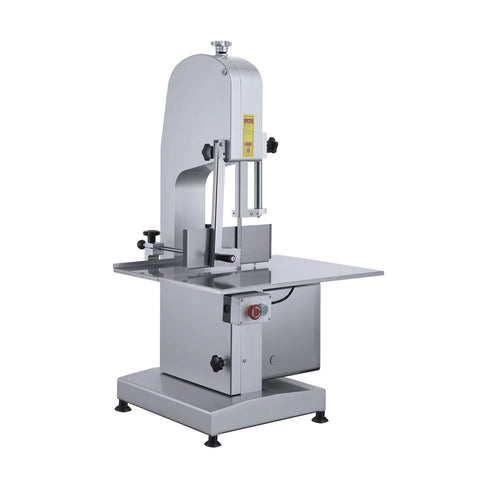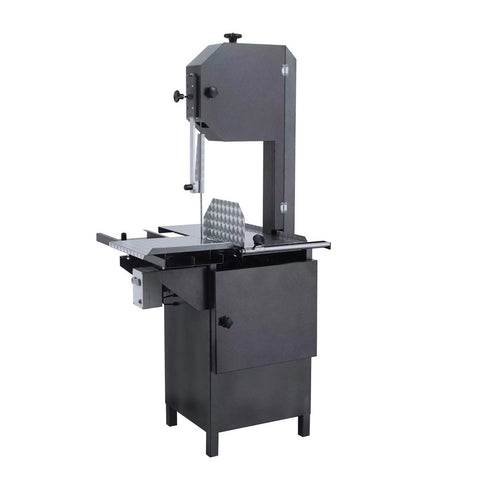
Recently Viewed

 Matador Heavy Duty Bone Saw HLS1650
Matador Heavy Duty Bone Saw HLS1650
480(W) x 460(D) x 870(H)mm


 Matador Benchtop Bone Saw JG300AH
Matador Benchtop Bone Saw JG300AH
590(W) x 490(D) x 1170(H)mm


 Matador Free Standing Bone Saw JG400AH
Matador Free Standing Bone Saw JG400AH
830(W) x 880(D) x 1775(H)mm
At Restaurant Equipment Online, we pride ourselves on being a trusted supplier of commercial kitchen equipment, including top-of-the-line bone saws. With over 10 years of experience serving the food industry, we have helped thousands of businesses across Australia & New Zealand find the perfect equipment for their needs. Our knowledgeable customer service team is ready to assist you in selecting the right commercial bone saw that fits your kitchen requirements and budget. We work with reputable brands like Matador and offer a wide range of options, ensuring you can find the ideal bone saw to enhance your kitchen's efficiency and productivity.
When you choose a commercial bone saw from Restaurant Equipment Online, you also benefit from our commitment to quality and reliability. Our bone saws are built to withstand the demands of a busy commercial kitchen, featuring durable construction, precise cutting capabilities, and safety features to protect your staff. Additionally, we provide warranty options and fast shipping to ensure a seamless purchasing experience. Trust us to equip your commercial kitchen with a high-performance bone saw that will make a noticeable difference in your food preparation process. Contact us today, and let us help you take your kitchen to the next level.
Commercial bone saws are essential items for your larger butcher shops, meat processing facilities, and even steakhouses and other businesses that handle large cuts of meat. Fast blade speeds and powerful motors in commercial meat saws cut through tough bone and thick cuts of meat swiftly. Motorised cutting is more precise and more economical than butchers cutting meat by hand.
Indeed, bone saws come in a range of sizes, catering to diverse kitchen needs. From compact handheld models designed for smaller cuts to larger, free-standing bone saws built to handle substantial quantities of meat, there is a suitable size available for every commercial kitchen in Australia. The size selection depends on the volume of meat processing required and the specific cutting tasks to be performed.
Absolutely! Bone saws are specifically designed to tackle the challenge of cutting through frozen bones. However, it is advisable to utilise bone saws explicitly engineered for this purpose. The Matador HLS1650 in our collection feature stronger blades and increased cutting power, enabling them to effortlessly slice through the hardness of frozen bones encountered in commercial kitchen operations.
Absolutely! Bone saw blades are replaceable, ensuring the longevity and continuous functionality of the bone saw. Most bone saws are equipped with detachable blades that can be easily removed and replaced when necessary. For optimal performance, it is recommended to use replacement blades recommended by the manufacturer, as they are designed to fit seamlessly and maintain the saw's cutting efficiency.
While bone saws excel in cutting through bones, they are primarily designed and optimised for this purpose. For boneless cuts in commercial kitchens, tools like meat mincers or chef's knives are generally preferred due to their precision and efficiency. It is crucial to assess the specific requirements of the task at hand and choose the most suitable tool to achieve the desired results effectively in a commercial kitchen environment.
While bone saws are primarily engineered for bone-cutting tasks, they do possess versatility beyond this singular function. Apart from efficiently cutting bones, bone saws can also be employed for various other kitchen activities. They are suitable for slicing fresh or frozen foods such as meat, effortlessly trimming excess fat from cuts of meat, or precisely portioning larger meat pieces. However, it is essential to exercise caution and ensure that the bone saw is appropriate for the specific task at hand.
Proper cleaning and maintenance of a bone saw are essential for its longevity and optimal performance. To clean the bone saw, disassemble the parts and meticulously wash them using warm, soapy water. Thoroughly remove any bone fragments or residue. After cleaning, ensure the saw is completely dry, preventing any chance of rust formation. Apply food-grade oil to lubricate the moving parts, keeping them smooth and functional. Regular maintenance practices, including blade sharpening and inspecting for loose or damaged components, are recommended to preserve the saw's efficiency.
The lifespan of a bone saw blade depends on several factors, including the frequency of use, the types of bones being cut, and the maintenance practices followed. With proper care, regular cleaning, and timely blade sharpening, a bone saw blade can last significantly longer before requiring replacement. Adhering to manufacturer guidelines for blade care and sharpening ensures prolonged usage and optimal performance.
The frequency of sharpening your blade will depend on the frequency of use and the type of bone being cut. You may want to sharpen the blade every few weeks if it is used regularly, but if you are only using it occasionally, it may not need to be sharpened as frequently.
When used correctly and adhering to proper safety precautions, bone saws are considered safe to use. It is crucial to familiarise yourself with the manufacturer's instructions to understand the specific operational guidelines. The Matador JG300AH in our collection is equipped with safety features like a door safety switch which cuts off power when the door is open.
Additionally, wearing appropriate protective gear, such as gloves and goggles, helps ensure the safety of the operator while using the bone saw.
The main types of Bone Saws are electric bone saws and manual bone saws.
This depends on your needs and requirements. If you need more speed, then an electric bone saw is best. If you have a smaller budget and do not need to cut a lot of meat, then a manual bone saw would be sufficient.
A fixed-blade saw has a stationary blade while the sliding blade saw has a moving blade on a track.
When buying a Bone Saw consider the blade length, type of blade, motor power, and the safety features.
A bone saw is incredibly versatile, capable of effortlessly slicing through an array of bones. From robust beef and succulent pork to delicate poultry and even fish, bone saws can handle different bone sizes and textures. They are ideal for cutting small to medium-sized animal bones commonly encountered in commercial kitchen operations.